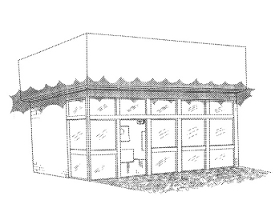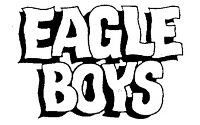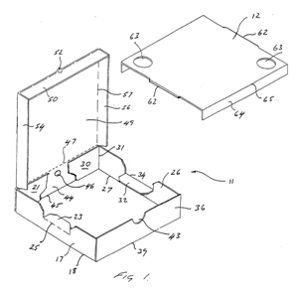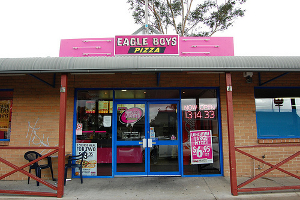In 1986, Tom Potter was 23 and without a job. Having left school at the age of 15 to begin his apprenticeship as a baker, he had traveled through different cities in his native Australia – Alice Springs, Melbourne and Adelaide – working in a variety of different food-industry related jobs, but could not seem to get his career as baker off the ground. One day he decided to take a chance and try his hand at opening a pizza restaurant. With very little capital he secured a partner (his mother Barbara) and in 1987 opened the first Eagle Boys Dial-A-Pizza Australia Pty Ltd (Eagle Boys) restaurant in Albury, New South Wales. Using radical, innovative and what some may describe as unusual business and marketing tactics, Mr. Potter took that single store and turned Eagle Boys into one of the largest pizza restaurant chains in Australia and New Zealand.
 The trademark application for the pink glow of Eagle Boys Pizza stores (IP Australia Trademark No. 585856)
The trademark application for the pink glow of Eagle Boys Pizza stores (IP Australia Trademark No. 585856)
Research and development
New restaurants come and go every day, and if it were not for Mr. Potter’s unique research and development (R&D) initiatives, Eagle Boys may have never made it past that first store in Albury. Mr. Potter’s extensive experience in flour milling technology and his background in bakery was more conducive to opening a successful bakery, not a pizza restaurant. But it was this knowledge that he drew upon to make Eagle Boys an entirely new and unique concept. The first restaurant was set up like a bakery in the back and a pizza shop in the front. In the bakery section, Mr. Potter tapped into his bakery skills to create a variety of pizza dough made with a baker’s touch to be used as the basis for the store’s pizzas. From thin to multigrain pizzas, the “bakery in a pizza shop” idea was turning out products – all made with fresh ingredients – that were very different from what customers were accustomed to. Eagle Boys advertised their products as semi-gourmet pizzas that were much different than the larger chains, yet cheaper due to the high production output.
This successful idea caught on, and the first store in Albury was quickly turning a handsome profit. Within less than a year, Eagle Boys opened up two more stores in the neighboring cities of Wagga and Dubb in the state of New South Wales. As the company sustained its growth, it put a lot of energy into researching ways to meet consumer demands in different regions. With stores opening up in rural, suburban and urban areas throughout Australia, the company found that no two locations were alike and that one blanket business model could not be used. It therefore developed five different store models that would work in different locations, and which became the foundation of the company’s early growth.
One particularly successful model was the development of a drive-thru pizza store in 1999, a concept which was unheard of at the time. Australia’s first drive-thru pizza store proved immensely popular at specific Eagle Boys locations, as people could quickly grab a delicious and unique meal, that fit into their busy lifestyle no matter where they were headed. Expanding on this quick pizza delivery system, the company launched the Eagle Boys Pizza Express Store shortly thereafter, which was designed to provide quick service pizza out of a small location in highly populated foot traffic areas.
With this model, the company specialized in two minute “express” pizzas sold in four different varieties (which were the company’s most popular pizza varieties) between 5:30 and 8:00pm. Eagle Boys achieved this by constantly remaking these four varieties and keeping them in a warmer for sale up to eight minutes after they were made. This ensured that pizzas could be delivered quickly, but were also guaranteed to be fresh.
The first Express Store was opened in 2003 at Brisbane’s Suncorp Stadium, and similar stores opened at Brisbane’s domestic and international airports the following year. It proved to be very popular, and new locations started to spring up at airports, shopping malls and pedestrian malls throughout the country. The immense popularity of the Express Stores led to the launching of Eagle Express menu items at all Eagle Boys locations in 2005, and many locations were generating up to forty percent of their sales from these products.
The company refined the model further with the development of a six inch pizza baking system designed especially for Express Stores. This system allows the company to produce pizza bases off site with the highest level of consistency and quality. The pizza bases are snap-frozen (partially baked then rapidly chilled) for delivery to each store, and once thawed they are simply topped as required and baked in approximately four minutes and thirty seconds.
As the company started to experience increased competition, it had to do something to differentiate its express pizza service from other companies offering similar products. Eagle Boys went back to the drawing board, and in 2008 it developed a popular offshoot menu for Eagle Express stores: “Ready, Fresh Go!”. The menu was changed to offer only three pizza varieties – two of the company’s most popular and a manager’s special – and the name reflected the fact that while it is an express delivery system, the pizzas are made fresh and held in specially-designed slow-cook ovens that ensure their freshness. In 2009, the company evolved further by creating a “Ready-2-Go” line of pizzas, which was made available in select stores.
The company’s dedication to research and response to consumer trends and the development of new, quality products quality culminated in the largest revamp of the Eagle Boys menu in its history. Launched in early 2010, the new menu featured a multitude of new items. Apart from new pizzas, novel items such as a chocolate fudge mousse dessert, pasta dishes, additional side dishes and drinks were introduced. Customers have responded with a resounding satisfaction, and throughout 2010 Eagle Boys enjoyed one of its biggest increases in sales in company history. “This industry recognition is testament to our focus on responding to customers’ needs and developing a new menu which focuses on quality ingredients and unbeatable taste,” said Ms. Christine Hooper of the Executive Marketing division.
Creating innovative and unique products and business models is what has propelled the company to success, and it continues to be a mainstay of Eagle Boys’ activities. From ground-breaking drive-thru pizza to unique store models and ordering via the Internet, Eagle Boys continues to develop new and accessible ways for its customers to purchase pizza, no matter where they might be.
Invention
Eagle Boys’ innovation did not stop at developing different store models or menu items. The company is constantly involved in coming up with new ways that it can be the best pizza restaurant in Australia, and one particular standout was the development of an ingenious two-tiered pizza delivery box. The idea came out of a desire to find a way to fit two pizzas in one box, but without the box turning soft and thus negatively impacting the flavor of the pizzas. Many customers were taking advantage of Eagle Boys’ two-pizza deals, and finding an economical and practical way to fit two pizzas in one box became an important R&D challenge.
The company quickly developed the two-tiered pizza delivery box, which also turned out to have a few other important – yet not readily apparent – advantages. First, the heat generated from two pizzas in one box keeps them both piping hot for a longer period of time, which means that the box will also hold its structural integrity longer. Second, the use of recycled paper stock increased the box’s strength while being environmentally friendly. Lastly, because less material is used to manufacture boxes, the company enjoyed a twenty percent savings on box expenses.
Branding

Eagle Boys enjoys high brand recognition and loyalty in Australia. This has been facilitated by the company’s innovative new products, insightful market research and successful advertising campaigns. One of the most important aspects of the company’s brand is the “pink glow” that surrounds each store. Each store is adorned with pink colored lights – either on the exterior or interior of the building – and this creates a unique, warm glow that is instantly recognizable. According to Mr. Potter, people all around Australia recognize the pink glow as Eagle Boys. “Customers love the fun and upbeat feel it creates in our stores,” he said. “We take great pride in our brand and corporate look, and the pink glow is a very important part of this.”
In an effort to get the brand even more exposure, in March 2010 the company changed its telephone number from the one it had used for over twenty years. The new number – 1300 EAGLE BOYS – uses the company’s name and is easy to remember. Eagle Boys uses one telephone number for all orders nationally, and routes callers to the store that is nearest to them. While the decision to change was difficult, customers can more easily remember the brand name instead of just a number. “Research shows phone names are up to twenty times more memorable than simple phone numbers and the more calls we receive, the more sales we make,” said Mr. Clayton. “At the same time, 1300 EAGLE BOYS will increase brand awareness as customers physically dial our name.” This new telephone number proved to be a winning idea, as by December 2010 the company enjoyed a 7.2% unaided telephone number recall rate, as opposed to 0.9% in March of the same year.
Unique approaches to branding such as these has given the company a lasting, high quality image and is an important tool it uses to differentiate itself from its competitors. As of early 2011, Eagle Boys is one of Australia’s best known pizza brands. A strong, easily recognizable name combined with new products and marketing initiatives have propelled Eagle Boys to become one of the most trusted brands in Australia, with the company enjoying high brand recognition and loyalty.
IP management
From the start, Mr. Potter understood the value of intellectual property (IP) and securing IP rights (IPRs). As a general rule, the company has an IP strategy to secure IPRs for all of its IP, from the company name to the innovative designs it uses for its pizza delivery boxes. For Eagle Boys, formal IP protection gives the company tangible, saleable assets which it can control centrally and then package into its franchise system. Doing so lessens the likelihood that competing business will infringe on the company’s IP.
Just as important as securing IPRs is an in-house understanding how to manage them. To that end, the company ensures that its public relations, marketing and design teams all understand that no new product developments, trademarks, slogans or any other valuable information can be divulged to the public before formal IPR applications have been made. The company’s franchisees know that the power of their franchise lies in the Eagle Boys IP. Because any premature public disclosure would only derail the company’s success – and the success of the franchisees – Eagle Boys works with an IP specialist to educate its employees and franchisees to ensure that the value of its IP is not needlessly compromised. In addition, all franchisees are educated on how to spot IP infringement and are the company’s eyes, ears and first line of defense against those who may wish to illegally ride the coattails of Eagle Boys’ success.
Patents and trademarks

Recognizing the need to protect its brand and unique innovations, Eagle Boys has secured patents and trademarks.
The company first applied for a trademark registration for its name with IP Australia in 1991, and has since registered other trademarks for its name, logo and slogans such as “Eagle Boys Ready When You Are” and “Eagle Boys Bigger. Better.”, which was registered in October 2009 to coincide with the company’s new menu and marketing campaign.
The trademark for its unique “pink glow” was successfully registered with the Intellectual Property office of the Australian Government (IP Australia) in 1992. The trademark is described as a “pink glow created by a row of pink colored lights extending along a fascia of a building or a pink glow created by pink colored lights mounted on the exterior or interior walls of a building”. It is limited to a building that provides the services of Class 42, which include the retail of food and beverages and restaurant services including the preparation, supply and sale of food and beverages.
In September 1996, Eagle Boys applied for a patent with IP Australia for its unique two-tiered pizza delivery box, which was granted in March 1998.
Franchising
The use of powerful yet simple franchising model was key to the successful expansion of Eagle Boys. After the company opened a few stores, it quickly realized that controlling and effectively managing all of these busy stores throughout the country was going to be an enormous challenge. In addition, it would be difficult to raise the required capital to build new stores. With the popularity of franchising quickly rising in the early 1990s, it seemed like the logical choice. This turned out to be true, and in the words of Mr. Potter, “…we turned to franchising, and the rest is history”.
Eagle Boys developed a very successful and lucrative franchise system that revolves around ten important principles: (1) support during the decision-making process; (2) cost-effective franchise entry price; (3) store location and building assistance program; (4) franchise training; (5) team selection and training; (6) extended support through training and day-to-day guidance; (7) regular visits by franchise business managers to improve sales, profitability and general management; (8) strong marketing, advertising and buying power support; (9) stable and dependable Australian-owned company; and (10) proven brand and dynamic products.
The franchise system is the mainstay of the company’s efforts, and its success is directly related to the flexible store models the company developed through its R&D. Franchisees are able to choose one of the following store models – all with proven track records – which best suit their needs and goals.
Standard Store: Representing the company’s roots, this model is a store that is large enough to meet the needs of metropolitan or regional centers with a population of over 10,000.
Drive-Thru Store: One of Eagle Boys’ many firsts, this model improves customer convenience and can effectively compete with a larger group of fast food chains, such as those that provide drive thru service but do not sell pizza.
Micro Store: Similar to the Standard Store, the Micro Store model provides all of the quality products of Eagle Boys, but is smaller and thus targets areas with a population between five and ten thousand.
Local Store: This model is designed to meet even smaller population centers than the Micro Store, but can bring in significant value-for-money business. Designed to dominate in markets where there is limited competition, this model allows attractive menu pricing and the potential to deliver considerable profits to franchisees.
Express Store: Designed to operate in space as small as six square meters, this model is one of the company’s most successful and caters to the busy customer on the go. It provides franchisees with a unique opportunity to create a profitable business in a very small space, producing high quality personal pizzas and healthy profit margins, all with low labor costs and minimal required infrastructure. The Express Store model is designed around simplicity, consistency and speed, with one store producing from 60 to 2,500 pizzas per hour. Adaptable to a range of applications, Express Stores can be independently branded kiosks or can be incorporated into an existing business.
The successful franchise model combined with Eagle Boys’ unique store models and products has allowed the company to experience rapid growth in a short time. It has also allowed the company to weather tumultuous economic times and is one of the major contributing factors towards its success.

Business results
Ingenious responses to consumer trends and market needs, a solid franchise model, a strong brand and protection of intangible assets through the IP system has proven to be a winning combination for Eagle Boys. In 2008, the company purchased Pizza Haven – one of its domestic competitors – and instantly increased its presence in many local markets.
In January 2010, Eagle Boys became the second largest pizza chain in Australia, and in March 2010 opened its 300th store in Sydney. The company continues to grow through its unique franchise system, and from June 2008 to June 2009 it opened over one new store per week. In the three months from January to March 2010, the company received over eight hundred franchise inquiries, nearly doubling the number from the previous year. By early 2011, Eagle Boys was making over sixteen million pizzas a year and generating an annual turnover of over AUD $160 million.
Eagle Boys’ successful franchise model and strong brand name have also been recognized on numerous occasions. In 2008, the company won the Australian National Retail Association’s Supreme Retailer Award, and in 2007 and 2008 it was awarded the Australian National Retail Association’s Best Franchise Retailer Award.
Seeing pink
By 2007, Tom Potter was preparing for his next idea – a gourmet bakery and coffee house – and decided to sell Eagle Boys. After turning one small shop with a unique idea into one of the most successful and well respected franchises in Australia, Mr. Potter turned a handsome profit and left the company in good hands. With the new owners came an influx of investment and some structural changes, but the pink glow remains. The company continues to grow, building on the foundational principles of a strong, well respected brand name and innovative R&D protected through intellectual property rights.

 Client Focus
Client Focus